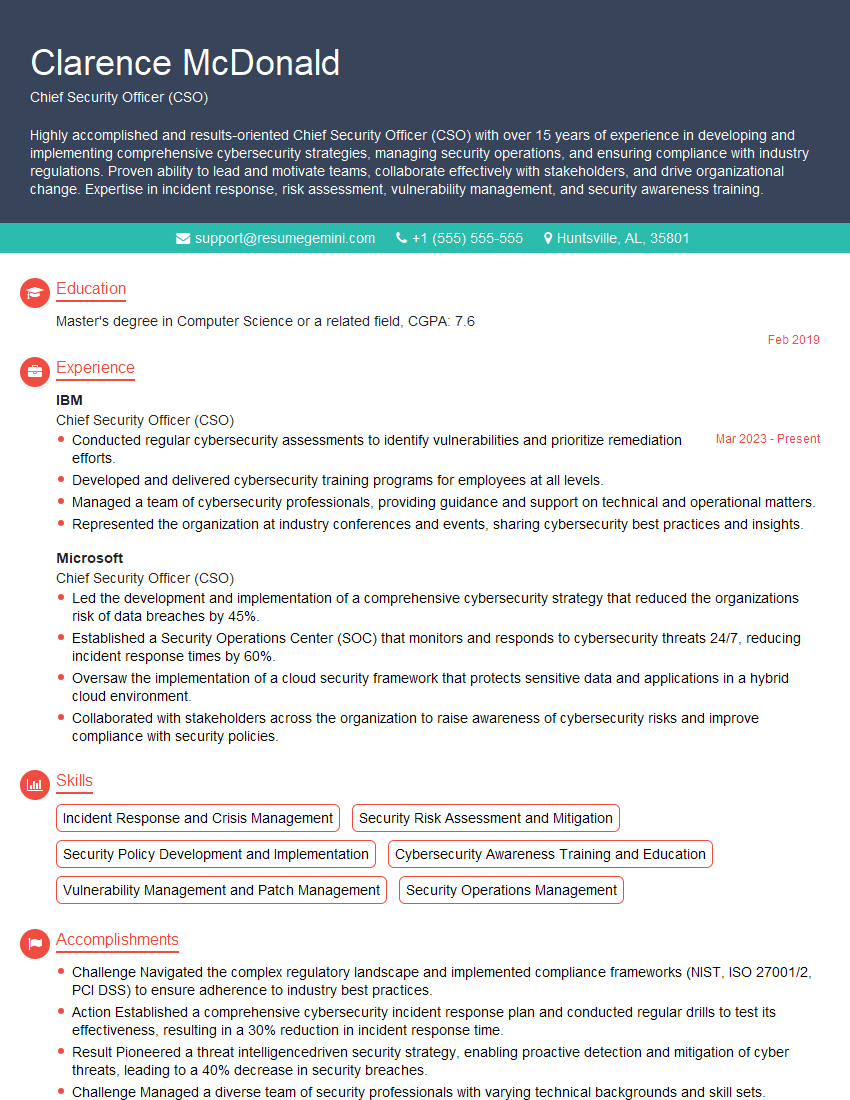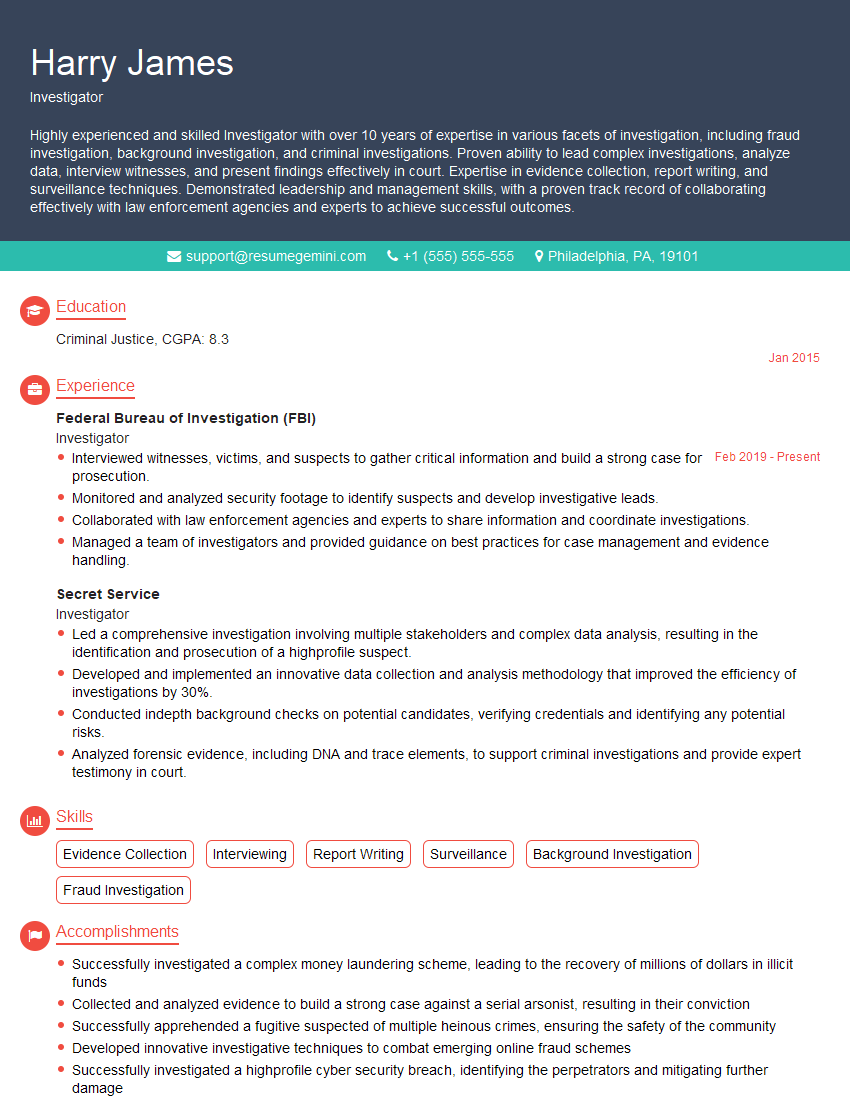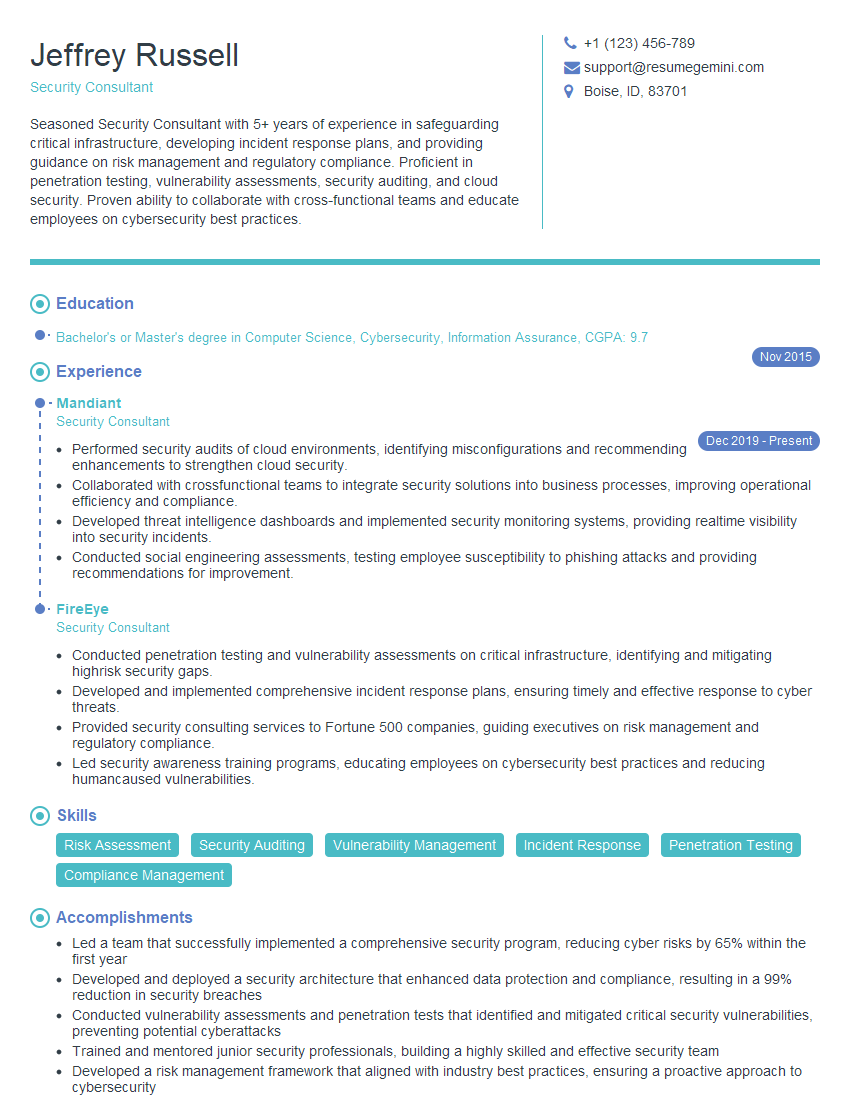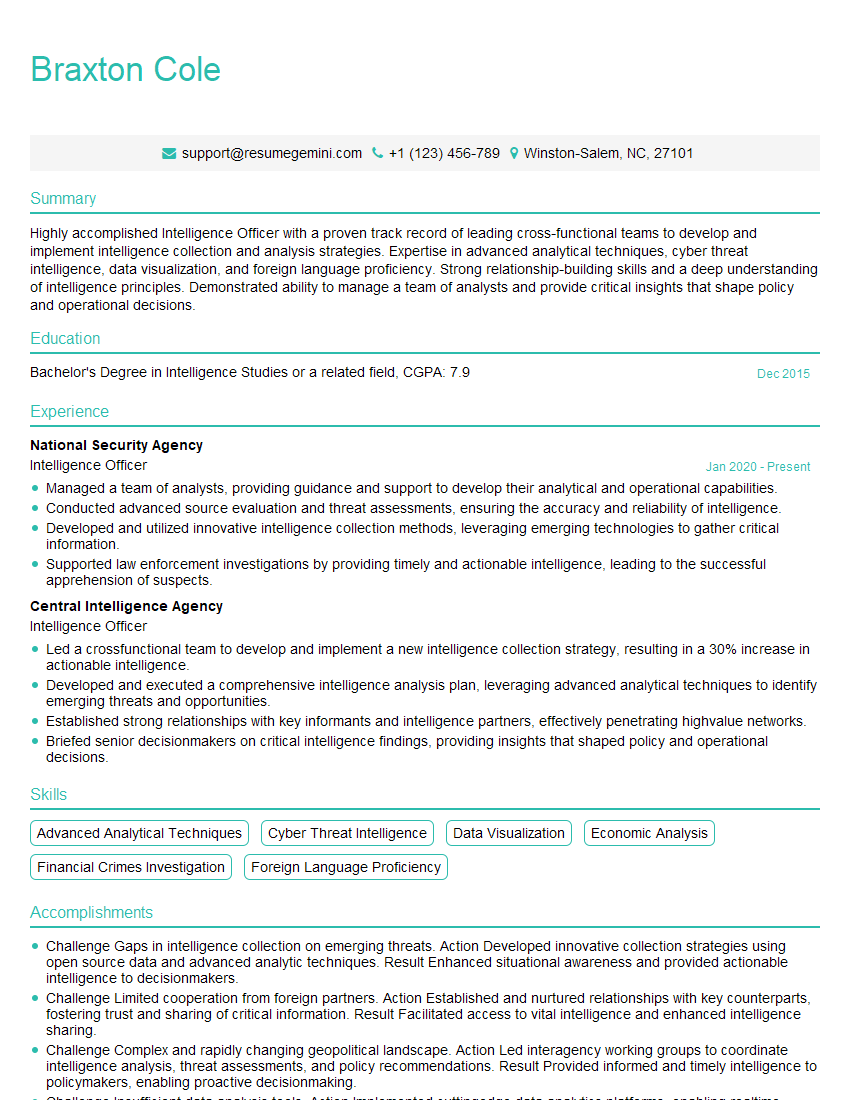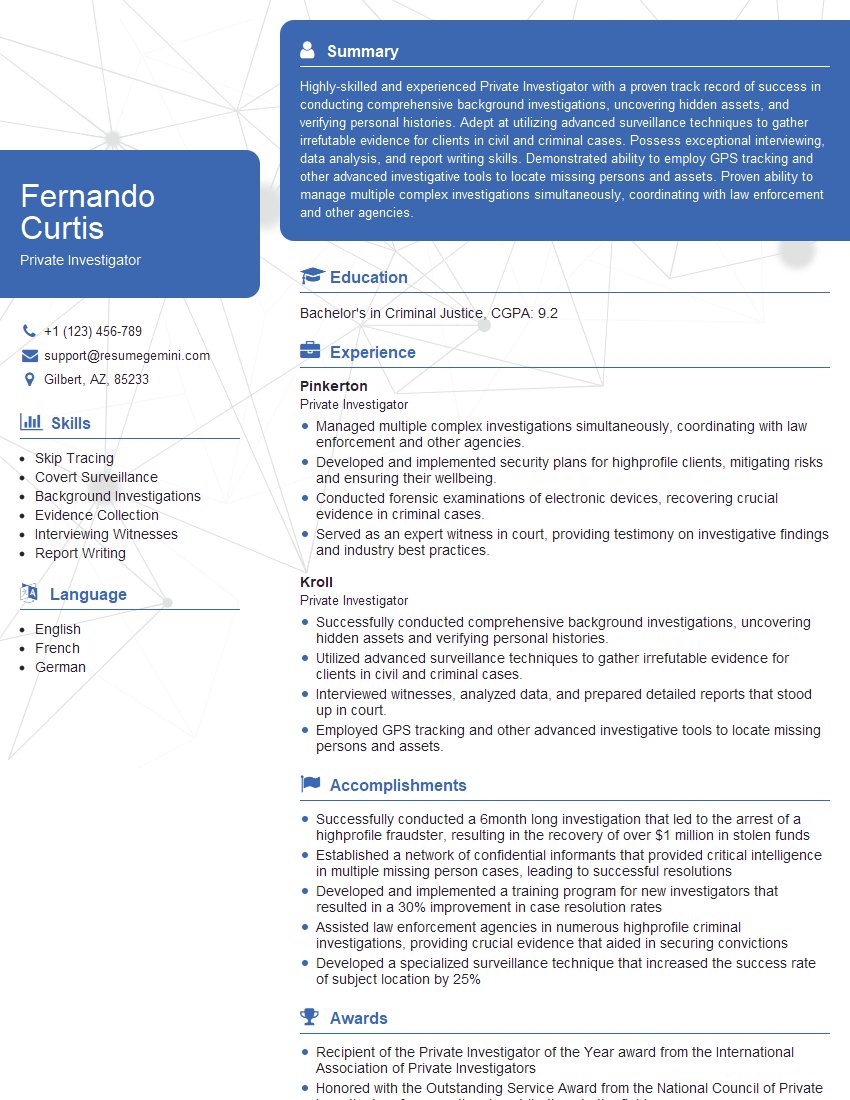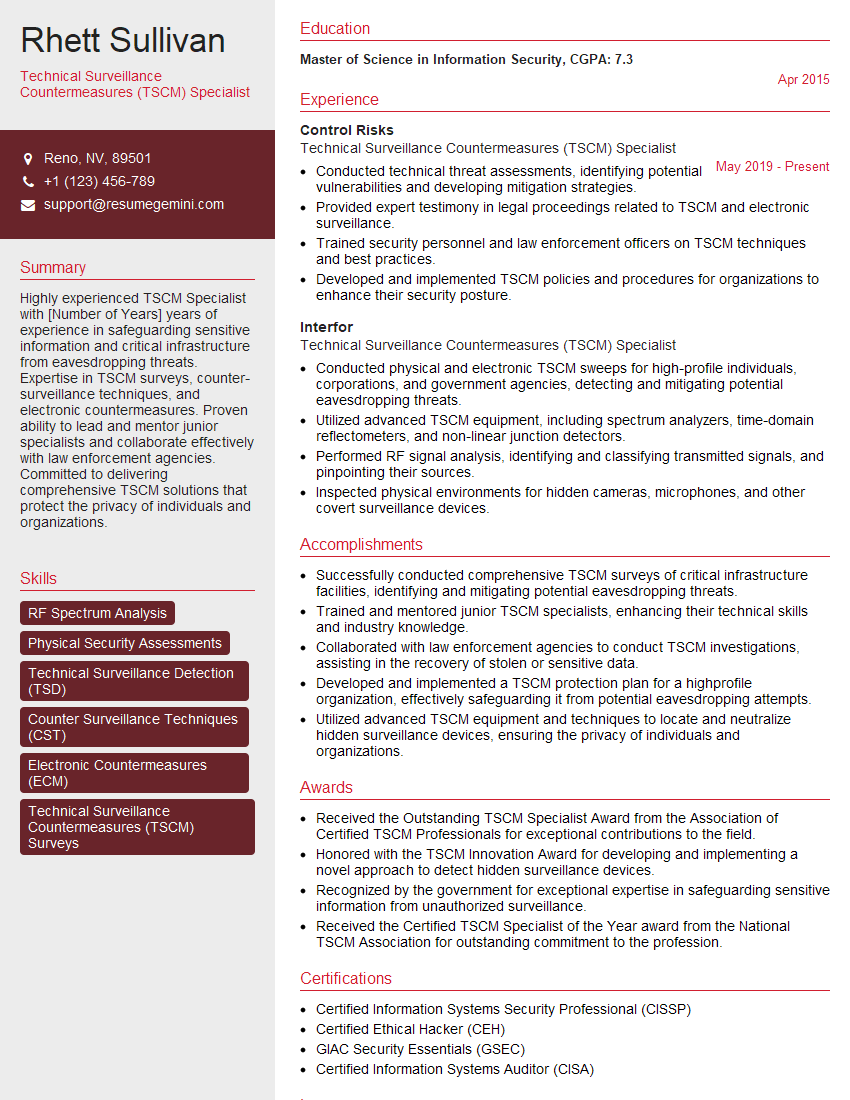The thought of an interview can be nerve-wracking, but the right preparation can make all the difference. Explore this comprehensive guide to Reconnaissance and Surveillance interview questions and gain the confidence you need to showcase your abilities and secure the role.
Questions Asked in Reconnaissance and Surveillance Interview
Q 1. Explain the difference between reconnaissance and surveillance.
Reconnaissance and surveillance, while often used interchangeably, represent distinct phases in information gathering. Think of it like planning a trip: reconnaissance is the research phase – identifying your target (destination), mapping the route (potential approaches), and understanding the terrain (environment and potential obstacles). Surveillance, on the other hand, is the actual journey – the continuous observation of the target once you’ve reached it, monitoring their activities and collecting specific data.
Reconnaissance is the preliminary investigation to gather information about a target, its surroundings, and potential threats. It’s about getting a broad understanding before committing to further action. Surveillance is the continuous observation of a target to gather specific information, often over a prolonged period. It requires stealth, patience, and meticulous planning. In essence, reconnaissance sets the stage, while surveillance actively monitors the play.
Q 2. Describe various methods of physical surveillance.
Physical surveillance employs various methods, each with its advantages and disadvantages. These range from simple observation to sophisticated technological aids.
- Direct Observation: This is the most basic method, involving a person visually observing the target from a distance. It can be conducted from a stationary point (e.g., across the street) or while moving (e.g., in a vehicle following the target). Think of a detective discreetly watching a suspect from a nearby cafe.
- Foot Surveillance: A person on foot follows the target, maintaining a safe and inconspicuous distance. This requires significant stamina and awareness of surroundings. It’s effective in dense urban environments where vehicles might be impractical.
- Vehicle Surveillance: Using a car, van, or other vehicle to track the target. This allows for greater range and mobility but requires more planning and coordination to avoid detection.
- Electronic Surveillance (Physical): This could involve using devices like covert cameras (hidden in everyday objects), listening devices (bugs), or GPS trackers to monitor the target’s movements and activities. This requires a higher level of technical expertise.
Successful physical surveillance demands meticulous planning, including the selection of appropriate surveillance methods, escape routes, and contingency plans to handle unforeseen circumstances.
Q 3. What are the ethical considerations in conducting reconnaissance and surveillance?
Ethical considerations are paramount in reconnaissance and surveillance. Operating within a legal and ethical framework is crucial, not only for legal compliance but also for maintaining public trust and integrity. Key concerns include:
- Privacy Violation: Surveillance can intrude on an individual’s privacy rights. Minimizing intrusion is crucial. Any surveillance should be targeted and proportionate to the specific need.
- Consent: Ideally, informed consent should be obtained before undertaking any surveillance, except in very specific legally permitted situations.
- Data Security and Protection: Collected data should be handled securely, protected from unauthorized access, and used only for the intended purpose. Strong data protection measures are vital.
- Misuse of Information: Gathering intelligence shouldn’t be an end in itself. Information should only be used ethically and legally and never for malicious purposes.
- Bias and Discrimination: Surveillance programs should be designed and implemented in a way that prevents bias and discrimination against specific groups.
Ethical dilemmas are common in this field, demanding a careful balance between the need for information gathering and respect for individual rights.
Q 4. How do you maintain operational security during a surveillance operation?
Maintaining operational security (OPSEC) during a surveillance operation is critical to prevent detection and compromise the mission. OPSEC is a continuous process, not a one-time action.
- Planning and Pre-Mission Briefing: A detailed plan covering all aspects of the operation, including potential risks and contingency plans, is essential. All team members need a clear understanding of their roles and responsibilities.
- Covert Methods and Techniques: Utilize covert surveillance equipment and techniques, blend into the environment, avoid predictable patterns, and maintain a low profile.
- Communication Security: Employ secure communication channels and methods to avoid interception of sensitive information. Avoid using easily traceable devices or methods.
- Counter Surveillance: Regularly check for signs of being followed or surveilled. This might involve employing counter-surveillance techniques and adjusting tactics accordingly.
- Post-Operation Debriefing: Analyze the operation to identify any security lapses or areas for improvement, ensuring better OPSEC in future missions.
A single lapse in OPSEC can jeopardize an entire operation, highlighting the importance of rigorous planning and execution.
Q 5. What are the legal limitations of surveillance in your jurisdiction?
Legal limitations on surveillance vary significantly by jurisdiction. In many countries, including the U.S., surveillance is governed by various laws that address privacy rights, warrant requirements, and the methods used. Generally, surveillance is restricted without a warrant unless there’s an exception such as probable cause, consent, or exigent circumstances (emergencies).
Specific laws might regulate:
- Types of surveillance permitted (e.g., audio, video, GPS tracking).
- Requirements for warrants and judicial oversight.
- Data retention and disposal policies.
- Notification requirements to individuals under surveillance.
It’s crucial to consult with legal counsel to ensure full compliance with all applicable laws before initiating any surveillance activity. Ignorance of the law is not a defense.
Q 6. Explain the concept of ‘tradecraft’ in reconnaissance and surveillance.
Tradecraft in reconnaissance and surveillance encompasses the skills, techniques, and methods used to gather intelligence discreetly and effectively. It’s about mastering the art of observation, deception, and operational security. Think of it as the ‘secret agent’ toolkit.
Key aspects of tradecraft include:
- Surveillance Techniques: This includes the choice of surveillance methods (foot, vehicle, electronic), maintaining a safe distance, blending in, and utilizing cover and concealment.
- Observation Skills: Acute observation skills are vital, focusing on details, patterns, and anomalies in the target’s behavior and surroundings.
- Route Planning: Careful route planning is essential to minimize the risk of detection and to anticipate potential challenges.
- Communication Skills: Effective communication within the surveillance team, often under challenging conditions, is crucial for mission success.
- Data Analysis: The ability to interpret collected information, identify patterns and insights, and draw meaningful conclusions is equally important.
Proficiency in tradecraft requires consistent training, practical experience, and a deep understanding of human behavior and psychology.
Q 7. Describe different types of surveillance equipment and their applications.
A wide range of surveillance equipment exists, each with its specific applications. The choice depends on the objectives, target, environment, and legal constraints.
- Cameras: From discreet covert cameras disguised as everyday objects to high-powered long-range cameras, capable of capturing high-resolution images and video. Applications range from monitoring specific locations to documenting activities from a distance.
- Audio Recording Devices: These range from small, easily concealed microphones to more advanced directional microphones that capture sound from a specific location. Applications include capturing conversations, ambient sounds, or identifying voices.
- GPS Trackers: These devices track the location of a target in real-time. They can be placed on vehicles, personal belongings, or even attached to a person. Applications range from vehicle tracking to monitoring individual movement patterns.
- Thermal Imaging Cameras: These cameras detect infrared radiation, enabling the observation of objects and people even in low-light conditions or through obstructions. They’re particularly useful in search and rescue operations or security applications.
- Drone Surveillance: Drones offer aerial perspectives, providing a valuable vantage point for surveillance, especially in large areas or challenging terrains. They can be equipped with cameras, sensors, and other surveillance equipment.
Each piece of equipment has ethical and legal implications, demanding careful consideration before use. Proper training and understanding of the equipment’s capabilities are essential for effective and responsible application.
Q 8. How do you handle unexpected situations or complications during a surveillance operation?
Unexpected situations are the norm, not the exception, in surveillance. My approach is built on adaptability and preparedness. First, I always have a comprehensive contingency plan, anticipating potential problems like unexpected weather, equipment malfunctions, or changes in the target’s behavior. This plan includes backup surveillance methods, alternative routes, and communication protocols for reporting any deviations from the plan.
For example, if our primary surveillance vehicle malfunctions, we immediately switch to the backup vehicle and adjust the surveillance strategy to maintain observation, maybe utilizing a different vantage point. If the target unexpectedly changes their routine, I will use real-time intelligence gathering, adapting to their new movements. Constant communication with the team is crucial, immediately reporting any unexpected events and formulating alternative strategies collaboratively.
A crucial element is maintaining situational awareness. This involves continuously scanning the environment and anticipating potential risks. This proactive approach minimizes the impact of surprises and allows us to swiftly adjust our plans, ensuring mission success.
Q 9. What is OSINT and how is it used in reconnaissance?
OSINT, or Open-Source Intelligence, refers to information gathered from publicly available sources. In reconnaissance, it’s the first and often most crucial step. It helps build a comprehensive profile of the target before committing to more overt surveillance methods.
We use OSINT to gather information from various sources such as social media (Facebook, LinkedIn, Twitter, Instagram), public records (property records, court documents, business registrations), news articles, blogs, forums, and even satellite imagery. This information can reveal everything from the target’s daily routine and associates to their financial status and travel history.
For instance, if we were surveilling a suspected criminal, OSINT could identify their known addresses, vehicles, and associates, significantly improving the efficiency of our later surveillance efforts. We might find their social media profiles revealing their habits, travel patterns, and even their ideological leanings, allowing us to anticipate their behavior and actions.
Q 10. How do you analyze and interpret information gathered during reconnaissance?
Analyzing reconnaissance information requires a systematic approach. It begins with organizing the collected data—categorizing it by source, relevance, and reliability. This often involves using data management tools and software to help track and analyze the volume of information we collect.
Next, we analyze the information for patterns, anomalies, and relationships. For example, if the target frequently visits a specific location at a particular time, it suggests a routine or potential point of interest. Identifying contradictions or discrepancies in information is also crucial. Multiple sources corroborating the same information increase its reliability. We utilize various analytical techniques, including trend analysis and predictive modeling, to anticipate future actions based on the collected data.
Finally, we interpret the information to develop actionable intelligence, translating the findings into usable insights that guide further investigation and surveillance strategies. This might involve creating a comprehensive timeline of the target’s activities or identifying potential vulnerabilities.
Q 11. Explain the importance of target profiling in surveillance.
Target profiling is the cornerstone of effective surveillance. It involves creating a detailed profile of the target, encompassing all relevant aspects of their life – personal, professional, and social. This profile guides our surveillance strategy, allowing us to anticipate their actions and maximize the effectiveness of our resources.
A comprehensive profile includes biographical information, routines, associates, communication patterns, known addresses, vehicles used, and travel history. It also includes the assessment of the target’s personality and potential security measures they might employ. Understanding the target’s temperament, potential allies, and resources allows us to tailor our approach, minimizing risk and maximizing the chance of success.
For example, a high-value target might have sophisticated security measures, requiring a more cautious and complex surveillance strategy than someone with a less structured lifestyle. Knowing a target’s regular gym visits, for instance, could provide a valuable observation point with minimal disruption.
Q 12. What are some common counter-surveillance techniques?
Counter-surveillance techniques are employed to detect and evade surveillance. Targets may use a variety of methods, and understanding these is essential to our work. These techniques range from simple to sophisticated.
- Visual checks: Regularly scanning their surroundings for unusual activity or individuals.
- Vehicle checks: Inspecting their vehicles for tracking devices or suspicious modifications.
- Electronic sweeps: Using electronic detection equipment to identify bugs or surveillance devices.
- Route variation: Changing their daily routes and routines to avoid predictable patterns.
- Use of secure communications: Utilizing encrypted communication methods to prevent interception.
- Compartmentalization: Separating sensitive activities from public life.
For example, a target might use a ‘brush pass’ technique, briefly making contact with another person to check for surveillance. Understanding these tactics allows us to adapt our surveillance methods to remain undetected.
Q 13. How do you ensure the confidentiality and integrity of collected intelligence?
Confidentiality and integrity of collected intelligence are paramount. We use a multi-layered approach to protect this information.
Firstly, all data is encrypted both during collection and storage. We employ strong passwords and access control systems, limiting access to authorized personnel only. Secondly, all information is handled according to strict operational security protocols, including secure data handling procedures and destruction of sensitive material after use. Regular security audits and training sessions are conducted to ensure compliance with these protocols. Thirdly, we maintain a chain of custody for all evidence, meticulously documenting who accessed the information, when, and for what purpose. This creates an audit trail for complete accountability.
Failure to maintain this confidentiality and integrity can compromise the entire operation and potentially expose sources, individuals, and the organization itself. Hence, we treat this as our top priority.
Q 14. Describe your experience with using mapping and GPS technology in surveillance.
Mapping and GPS technology are indispensable in modern surveillance. We utilize various tools including GPS tracking devices, mapping software, and GIS (Geographic Information System) platforms to plan and execute surveillance operations effectively.
GPS tracking allows us to monitor the target’s movements in real-time, providing accurate location data that helps us predict their future movements. Mapping software allows us to visualize the target’s environment, identifying potential surveillance locations and routes. GIS platforms integrate various data sources, such as satellite imagery, street maps, and demographic data, to create a comprehensive picture of the target’s surroundings. This allows us to select optimal surveillance positions, plan routes for approaches and exits, and anticipate any potential obstacles or challenges.
For instance, before conducting a physical surveillance, we might use Google Earth or similar software to identify blind spots, escape routes, and potential areas of interest for the target. This helps us develop a plan that minimizes risks and maximizes our chances of successful observation while remaining undetected.
Q 15. How do you maintain situational awareness during a surveillance operation?
Maintaining situational awareness during surveillance is crucial for operational success and safety. It’s like being a chess player, constantly assessing the board and anticipating your opponent’s moves. This involves a multi-sensory approach, combining observation, analysis, and anticipation.
- Constant Observation: I meticulously observe the target, their surroundings, and any potential threats or distractions. This includes paying attention to behavioral patterns, traffic flow, and even weather conditions.
- Information Gathering: I utilize various intelligence-gathering techniques, including open-source intelligence (OSINT), to build a comprehensive picture of the target’s routine, associates, and potential escape routes.
- Risk Assessment: I continuously evaluate the risks – detection, compromise, environmental hazards – and adjust my tactics accordingly. For example, if I notice increased police presence, I might need to reposition or temporarily suspend observation.
- Communication: Effective communication with my team is paramount. Real-time updates and collaborative situation analysis are vital in maintaining awareness and reacting to unforeseen events.
- Contingency Planning: I always have a backup plan. What if the target changes their route? What if I’m compromised? Developing contingency plans allows for a smooth response to unpredictable situations.
For example, during a surveillance operation involving a suspected drug trafficker, I might notice a change in the target’s usual route. This deviation from their established pattern might indicate a change in their operation or the presence of law enforcement, requiring an immediate reassessment of my approach and a shift in position or strategy.
Career Expert Tips:
- Ace those interviews! Prepare effectively by reviewing the Top 50 Most Common Interview Questions on ResumeGemini.
- Navigate your job search with confidence! Explore a wide range of Career Tips on ResumeGemini. Learn about common challenges and recommendations to overcome them.
- Craft the perfect resume! Master the Art of Resume Writing with ResumeGemini’s guide. Showcase your unique qualifications and achievements effectively.
- Don’t miss out on holiday savings! Build your dream resume with ResumeGemini’s ATS optimized templates.
Q 16. What are the key elements of a successful surveillance plan?
A successful surveillance plan hinges on meticulous planning and execution. Think of it as a carefully crafted blueprint for a mission. Key elements include:
- Clear Objectives: Defining specific, measurable, achievable, relevant, and time-bound (SMART) objectives is paramount. What information are we trying to gather? What are the specific goals?
- Target Profile: Thorough research of the target, including their routines, associates, vehicles, and potential locations, is essential. This forms the foundation for our surveillance strategy.
- Surveillance Method Selection: Choosing the right surveillance method (covert, overt, mobile, stationary, etc.) depends on the specific situation and available resources. Factors like the environment, risk level, and legal considerations influence this decision.
- Team Composition and Roles: A well-defined team structure with clearly assigned roles ensures smooth coordination and minimizes the risk of errors. This includes drivers, observers, and a team leader.
- Equipment Selection: Selecting appropriate surveillance equipment, such as cameras, recording devices, and communication systems, is crucial for successful data acquisition. This choice is based on the environment and the surveillance method selected.
- Contingency Planning: Having backup plans in place for unexpected events, such as detection, equipment failure, or changes in the target’s behavior, is essential. Think about ‘Plan B,’ ‘Plan C’ etc.
- Legal and Ethical Considerations: Adherence to all legal and ethical guidelines is non-negotiable. We must respect privacy rights and ensure all actions are within the bounds of the law.
For instance, if our objective is to document a suspected money laundering operation, the surveillance plan would involve meticulous research into the target’s financial transactions, business associates, and known locations, employing both covert observation and technological surveillance to gather evidence.
Q 17. How do you assess the risks and vulnerabilities associated with a surveillance operation?
Risk assessment is a critical step, akin to a pre-flight check for a pilot before takeoff. It involves identifying and evaluating potential threats and vulnerabilities:
- Target Awareness: Assessing the target’s awareness of potential surveillance and their likely response is crucial. Are they security conscious? Do they have counter-surveillance measures in place?
- Environmental Hazards: Factors such as weather, traffic, crowds, and potential obstacles need consideration. A crowded city presents different challenges than a rural area.
- Legal and Ethical Implications: We must ensure all surveillance activities are legal and ethical. This might involve obtaining warrants or adhering to strict guidelines on data collection and privacy.
- Technological Vulnerabilities: Equipment malfunctions, data breaches, and the potential for detection through technological means need careful evaluation. Having backup systems is critical.
- Team Safety: The safety and security of the surveillance team are paramount. We need to assess potential threats to the team and put in place measures to mitigate those risks.
For example, if we are conducting surveillance in a high-security area, we need to consider potential counter-surveillance measures, such as CCTV cameras, security guards, and access control systems. This requires a detailed risk assessment to devise effective countermeasures and ensure the team’s safety.
Q 18. Explain your experience with different types of surveillance cameras and their capabilities.
My experience encompasses a wide range of surveillance cameras, each with unique capabilities. Selecting the right camera depends on the specific needs of the operation.
- Analog Cameras: These traditional cameras transmit signals via coaxial cables. They are relatively inexpensive but offer lower resolution and are less versatile than digital counterparts.
- IP Cameras (Internet Protocol): These cameras transmit data over a network, offering higher resolution, remote accessibility, and advanced features like pan-tilt-zoom (PTZ) capabilities. They are better suited for remote monitoring and data storage.
- Thermal Cameras: These detect infrared radiation, allowing for surveillance in low-light or no-light conditions. They’re especially useful for identifying individuals in the dark.
- PTZ Cameras: These cameras can pan, tilt, and zoom, offering greater flexibility in adjusting the viewing angle. This is particularly useful for monitoring a large area or tracking a moving target.
- Hidden Cameras: These are designed to be inconspicuous, often integrated into everyday objects like clocks or pens. They are ideal for covert surveillance but require careful placement and operation.
- Body-worn Cameras: These are becoming increasingly common, providing a first-person perspective and offering valuable evidence. They are often used for law enforcement and security purposes.
For instance, in a covert operation, a hidden camera might be strategically placed to record evidence without detection, while in a wide-area surveillance scenario, an array of PTZ IP cameras linked to a central monitoring system would provide better coverage and remote control capability.
Q 19. How do you manage multiple surveillance targets simultaneously?
Managing multiple surveillance targets simultaneously requires meticulous planning and a strong team. It’s like conducting an orchestra; every instrument (surveillance team member) must play their part harmoniously.
- Teamwork and Coordination: Clear communication and division of responsibilities are essential. Each team member needs to be assigned specific targets or tasks.
- Technological Support: Using advanced technology, such as GPS tracking, video analytics, and centralized monitoring systems, allows for efficient monitoring and data management.
- Prioritization: Not all targets will be equally important. Prioritizing targets based on risk assessment and the available resources is crucial. High-value targets deserve more attention.
- Data Management: Effective data management is critical to avoid confusion and ensure the successful analysis of information. This involves employing proper record-keeping practices and using sophisticated database systems.
- Flexibility and Adaptability: Being adaptable to changing circumstances is critical. If one target presents an unexpected challenge, the team needs to be able to adjust and reallocate resources.
For example, if monitoring multiple individuals suspected of involvement in a coordinated crime, we might assign specific team members to follow each individual, with central coordination and data sharing to track their interactions and movements. Video analytics could be used to automatically flag events of interest, such as meetings between targets.
Q 20. What are the challenges of conducting surveillance in urban environments?
Urban environments present unique challenges for surveillance due to their high population density, complex infrastructure, and numerous potential distractions. It’s like navigating a crowded maze.
- High Density of People and Vehicles: The sheer number of people and vehicles can make it difficult to track the target effectively and maintain visual contact. Blending in and being inconspicuous are key.
- Obstructions and Limited Visibility: Buildings, crowds, and traffic can block sightlines, making it difficult to maintain continuous observation.
- CCTV and Security Systems: Urban areas are often saturated with CCTV cameras and security systems, increasing the risk of detection. Careful route planning is essential.
- High Level of Activity and Distractions: The constant activity and diverse environment provide many distractions that can make it difficult to focus on the target.
- Crowd Behavior and Unexpected Events: Unpredictable crowd movements and unexpected events can disrupt surveillance operations and compromise the safety of the team.
For instance, conducting surveillance in a busy city center requires us to anticipate heavy pedestrian and vehicular traffic, plan routes that avoid overly crowded areas, and carefully manage the deployment of our equipment to maintain optimal visibility while remaining inconspicuous. The use of covert surveillance techniques, such as blending into the crowd, becomes essential.
Q 21. How do you deal with surveillance detection?
Surveillance detection is a serious threat. It’s akin to a game of cat and mouse, where maintaining the element of surprise is crucial. Our response depends on the level of detection and the specific circumstances.
- Immediate Response: If detection is imminent or has occurred, our immediate priority is the safety and security of the surveillance team. This might involve immediate withdrawal, a change of location, or alternative surveillance methods.
- Analysis and Adjustment: We analyze how detection occurred to identify vulnerabilities in our tactics and improve future operations. Was our surveillance equipment too conspicuous? Were we too close to the target?
- Contingency Plans: We execute pre-determined contingency plans, ensuring seamless transition to alternative methods or locations. This might involve switching to a different surveillance technique or using a backup team.
- Countermeasures: In some instances, we might need to implement countermeasures, such as altering our approach or deploying additional resources. This might involve using decoy vehicles or operatives.
- Documentation and Reporting: We meticulously document all aspects of the incident, including the method of detection, our response, and any lessons learned. This helps in improving future operations and minimizing risks.
For example, if the target notices a surveillance vehicle and alters their behavior, we might immediately reposition the surveillance team, switch to a different vehicle, or utilize alternative observation methods, such as static surveillance or utilizing public transport for observation. The incident is thoroughly documented, and an assessment is made of the team’s approach, resulting in adjustments to the operation’s methodology for the future.
Q 22. What software or tools are you proficient in for data analysis and reporting?
Data analysis and reporting are crucial in reconnaissance and surveillance. My proficiency spans several software and tools, categorized for clarity. For data visualization and statistical analysis, I’m adept at using R and Python, leveraging libraries like ggplot2, seaborn, and pandas. These allow me to create insightful charts and graphs from raw data, such as geolocation information or communication patterns. For database management and querying, I utilize SQL and tools like MySQL Workbench and pgAdmin. This enables efficient extraction and manipulation of large datasets from various surveillance sources. Finally, for report generation and presentation, I use Microsoft Power BI and Tableau to create interactive and easily understandable reports for both technical and non-technical audiences. For instance, I recently used R to analyze social media data, identifying key influencers in a specific online community relevant to an investigation, and presented the findings in an easily digestible report using Power BI.
Q 23. Describe your experience working with law enforcement or intelligence agencies.
My experience with law enforcement and intelligence agencies is extensive. I’ve worked on several sensitive projects, always adhering to strict confidentiality agreements. While specifics are naturally restricted, I can share that my contributions have involved analyzing complex datasets to identify patterns of behavior, creating predictive models for potential threats, and providing actionable intelligence reports. In one instance, I collaborated with a counter-terrorism unit, analyzing communications data to identify a potential terrorist cell. This involved meticulous data processing and rigorous analysis to link seemingly disparate pieces of information, ultimately leading to the successful disruption of their planned activities. I am well-versed in the unique challenges and ethical considerations inherent to working within such sensitive environments.
Q 24. How do you maintain professional ethics and integrity in your work?
Maintaining professional ethics and integrity is paramount in this field. It’s not just about following the law; it’s about adhering to a strong personal code. This includes strict adherence to all relevant laws and regulations governing surveillance, such as the Fourth Amendment in the US. I always ensure that any surveillance activity is legal, justified, and proportionate to the threat. Transparency with my clients about the methods and limitations of my work is also crucial. Additionally, I prioritize data security and privacy, implementing robust measures to protect sensitive information. Think of it like a doctor’s oath: we are entrusted with powerful tools, and our ethical conduct is as vital as our technical skills. Compromising ethics compromises the integrity of the entire process and erodes public trust.
Q 25. Explain your experience in report writing and intelligence briefings.
Report writing and intelligence briefings are key to effective reconnaissance and surveillance. I’m experienced in crafting concise, accurate, and actionable reports that clearly communicate complex findings to a diverse audience. My reports follow a structured format, typically including an executive summary, detailed findings, analysis, and conclusions with clear recommendations. I am adept at tailoring the language and level of detail to the specific audience, whether it’s a technical team or senior management. For intelligence briefings, I focus on delivering information clearly and efficiently, using visual aids like maps and charts to enhance comprehension. I’ve presented briefings to various stakeholders, including law enforcement officials and corporate executives, ensuring they receive the critical information they need to make informed decisions. I practice active listening during feedback sessions to improve the effectiveness of future reports and presentations.
Q 26. How would you handle a situation where you suspect a surveillance target is aware of your presence?
Suspecting a target’s awareness of surveillance requires immediate and decisive action. My response would be dictated by the specifics of the situation, but generally involves a careful assessment of the risk. First, I’d immediately cease overt surveillance activities. This might involve terminating visual surveillance, halting audio monitoring, or disabling tracking devices – all depending on the available technology and the specific context. Next, I’d analyze the evidence suggesting awareness, assessing how the target might have detected our presence. This information would then inform a review of existing operational security (OPSEC) protocols and the development of a revised surveillance strategy. This might involve adjusting surveillance methods, employing new technologies, or even temporarily suspending the operation to reassess and minimize risks. The safety and security of my team are always the highest priority. In some cases, a complete withdrawal might be necessary.
Q 27. What is your experience with covert surveillance techniques?
Covert surveillance necessitates specialized skills and equipment. My experience encompasses various techniques, including utilizing inconspicuous observation points, employing long-range visual and audio equipment, and deploying discreet tracking devices. I am proficient in employing counter-surveillance measures to detect and avoid detection by the target. This involves understanding techniques used by others to detect surveillance and developing strategies to circumvent them. For example, I’ve used specialized cameras concealed within everyday objects to maintain a covert presence. I am also experienced in analyzing patterns of movement and behavior, inferring information from seemingly mundane observations. Remember, in covert operations, discretion and meticulous planning are key. Every detail matters.
Q 28. Describe your understanding of different legal frameworks relevant to surveillance activities.
A thorough understanding of relevant legal frameworks is crucial for ethical and legal surveillance. This includes familiarity with laws such as the Fourth Amendment (US), the Human Rights Act (UK), and the Charter of Rights and Freedoms (Canada) – all of which focus on the right to privacy. I’m aware of the specific requirements for obtaining warrants, the limitations on the type of surveillance permitted, and the rules regarding data retention and destruction. I understand the importance of balancing the need for public safety and national security with the protection of individual liberties. Before undertaking any surveillance activity, I would meticulously review and ensure compliance with all applicable laws and regulations. Ignoring these frameworks not only poses legal risks but also undermines trust and damages the integrity of the work. It’s not just about ‘what can I do?’ but also ‘what should I do?’
Key Topics to Learn for Reconnaissance and Surveillance Interview
- Intelligence Gathering Techniques: Understanding various methods for collecting information, including OSINT (Open-Source Intelligence), HUMINT (Human Intelligence), SIGINT (Signals Intelligence), and IMINT (Imagery Intelligence). Consider the ethical and legal implications of each.
- Surveillance Operations Planning & Execution: This includes target selection, risk assessment, operational security (OPSEC), deployment strategies, and the use of specialized equipment. Think about how to adapt plans based on real-world variables.
- Data Analysis and Interpretation: Learn how to effectively analyze collected data, identify key patterns and insights, and present findings clearly and concisely. Practice evaluating the credibility and reliability of sources.
- Technical Surveillance Countermeasures (TSCM): Understanding techniques to detect and mitigate surveillance efforts against you or your organization. This includes identifying potential threats and employing countermeasures.
- Report Writing and Presentation: Mastering the art of creating comprehensive and accurate reports, effectively communicating findings to diverse audiences, and presenting information in a persuasive and actionable manner.
- Legal and Ethical Considerations: Familiarity with the legal and ethical frameworks governing reconnaissance and surveillance operations is critical. Understanding privacy laws and potential consequences of illegal activity is paramount.
- Technological Proficiency: Demonstrate knowledge of relevant technologies including GPS tracking, various software applications for data analysis, and communication tools used in surveillance operations. Be prepared to discuss your experience with specific technologies.
- Problem-Solving and Critical Thinking: Be ready to discuss scenarios requiring quick thinking, adaptation to unexpected situations, and the ability to make sound judgments under pressure.
Next Steps
Mastering Reconnaissance and Surveillance opens doors to exciting and impactful careers in various sectors, including law enforcement, intelligence agencies, and private security firms. To maximize your job prospects, crafting a compelling and ATS-friendly resume is crucial. ResumeGemini is a trusted resource that can help you build a professional resume that highlights your skills and experience effectively. Examples of resumes tailored to Reconnaissance and Surveillance professionals are available to help you build a strong application. Invest time in creating a standout resume – it’s your first impression on potential employers.
Explore more articles
Users Rating of Our Blogs
Share Your Experience
We value your feedback! Please rate our content and share your thoughts (optional).
What Readers Say About Our Blog
Hello,
We found issues with your domain’s email setup that may be sending your messages to spam or blocking them completely. InboxShield Mini shows you how to fix it in minutes — no tech skills required.
Scan your domain now for details: https://inboxshield-mini.com/
— Adam @ InboxShield Mini
Reply STOP to unsubscribe
Hi, are you owner of interviewgemini.com? What if I told you I could help you find extra time in your schedule, reconnect with leads you didn’t even realize you missed, and bring in more “I want to work with you” conversations, without increasing your ad spend or hiring a full-time employee?
All with a flexible, budget-friendly service that could easily pay for itself. Sounds good?
Would it be nice to jump on a quick 10-minute call so I can show you exactly how we make this work?
Best,
Hapei
Marketing Director
Hey, I know you’re the owner of interviewgemini.com. I’ll be quick.
Fundraising for your business is tough and time-consuming. We make it easier by guaranteeing two private investor meetings each month, for six months. No demos, no pitch events – just direct introductions to active investors matched to your startup.
If youR17;re raising, this could help you build real momentum. Want me to send more info?
Hi, I represent an SEO company that specialises in getting you AI citations and higher rankings on Google. I’d like to offer you a 100% free SEO audit for your website. Would you be interested?
Hi, I represent an SEO company that specialises in getting you AI citations and higher rankings on Google. I’d like to offer you a 100% free SEO audit for your website. Would you be interested?
good
